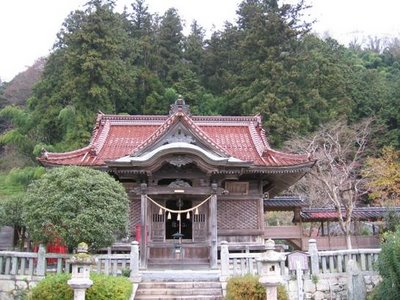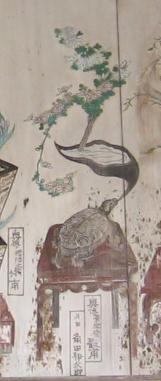Ho-Un Shrine, Hoo Un no Miya 宝雲宮
Entrance with Gate

The Gables


Great Demon Gable Tile (onigawara 鬼瓦)

Inside, Lampions with the name of the deity
宝雲大権現

The innermost shrine with the sacred mirror

Beautiful woodwork at the sides

Look at more small shrines at the side of this temple !
Until # 91.
:::::::::::::::::::::::::::::::::::::::::::::::::::::::::::::::::::::::::::::::::::::::::::::::::::::
Painted wooden boards with Bonsai motives
Considering the fact that they outside at the side of the temple below the roof, the colors are still very vivid indeed!


A turtle holding the pot

A gourd

An old haiku comes to mind
admiring bonsai !
time passes elegantly this
summer night
:::::::::::::::::::::::::::::::::::::::::::::::::::::::::::::::::::::::::::::::::::::::::::::::::::::
BACK TO
Katsuyama, a postal station of the Road to Izumo
***********************
Please send your contributions to Gabi Greve
Alphabetical Index of the Daruma Museum
Worldkigo Database








2 comments:
Hi Gabi.
A small set (4) of your photos of Katsuyama were identified as "bonsai."
They appear to be cut flowers in a variety of receptacles. The gourd on a hanging board offers chabana (tea flower) display style. Another display has an apparent wood tray of double-lozenge shape that is lined with copper-- a tray for flower display rather than soil.
My deeper interest is in the presentation. The stands holding flowers at a variety of depths and heights along the painting's length is typical of banquet style display for bonsai associated with sencha tea in the mid-Meiji period. The display style is a precursor to public exhibit style for objects not hung on walls.
Did you note anything about the painting's history or inscription beyond its image? Thanks for sharing it!
C. from America
.....................................
Unfortunately I could not get any further information. If I visit the temple again, I have to make sure the head priest is at home !
GABI
::::::::::::::::::::::::::::::::::::::::::::::::::::::::::::::::::::::::::
Dear C. san
I have seen similar "presentations" as woodblock prints in TV shows about ikebana and bonsai. The vases and pots are rather spectacular indeed.
I was very surprized to find them here on the outside, withering away, in such a small temple in the back parts of Japan.
Gabi
.....................................
Hi Gabi.
Thanks for your generous response.
Scholars pay close attention to histories of painting & its display. There is much less focus on the presentation of other arts and crafts.
In transition from private to public display, circles of art patrons & practitioners as well as tea ceremony groups established settings for selected appreciation of arts and crafts. A temple setting is itself important, perhaps related to an event of consequence to a patron of the temple.
In public exhibits, a large set of objects are displayed sequentially such that many visitors could observe them. Choice in display sometimes suggest intimacy (with separate alcoves or visual breaks along a wall to contain separate scenes).
Others exhibits display a single long facade-- often using dynamic asymmetry achieved with footed stands of varying height & variance in depth of object placement. The same techniques have meaning in intimate alcove placement but with different intention.
Cut flowers and bonsai serve a similar but somewhat different aubdience. Each wishes to express feeling for season, nature, unbound space represented in a small display, passage of time et al..
I deeply appreciate your pursuit of roots in Japanese art & meaning, and your very generous sharing.
Best wishes,
C. from America
..........................................................................
Post a Comment